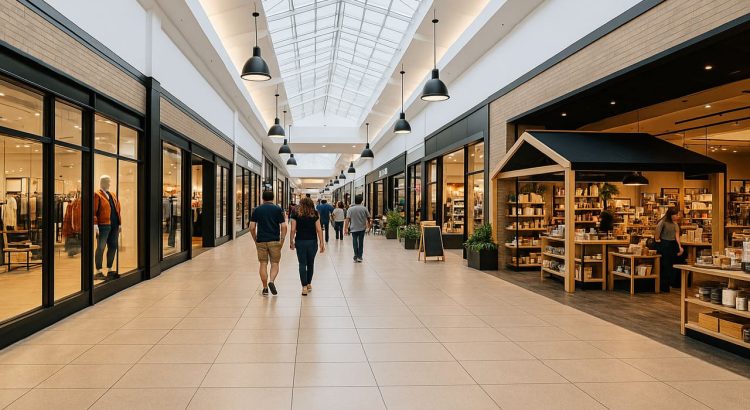The Berkshire Mall – The retail industry has undergone a significant transformation, largely driven by technology, evolving consumer behavior, and shifts in lifestyle expectations. The traditional divide between physical stores and e-commerce is blurring, giving birth to what is now widely recognized as hybrid retail. In the context of malls, hybrid retail combines in-person shopping with digital features, creating an integrated experience that offers convenience, personalization, and innovation.
Unlike conventional retail, where the focus was simply on physical transactions, hybrid retail embraces omnichannel strategies. Consumers can browse online, test products in-store, and finalize their purchase via mobile apps or touchless kiosks within the mall. This integration allows shopping centers to remain relevant in a market where convenience often dictates loyalty.
Why Hybrid Retail Matters in Malls
Shopping malls have long been community hubs, offering more than just retail they provide social spaces, entertainment, and dining options. However, the rise of e-commerce has challenged their role. Hybrid retail responds to this challenge by combining the sensory richness of physical shopping with the efficiency of digital tools.
The benefits of hybrid retail in malls include:
- Seamless experiences: Customers can shift between online browsing and offline shopping without interruption.
- Data-driven personalization: Retailers in malls can leverage apps and loyalty programs to offer tailored recommendations.
- Greater customer engagement: Hybrid models encourage interaction, from augmented reality fitting rooms to mobile-exclusive promotions redeemable in-store.
By embracing hybrid strategies, malls are not only surviving but also regaining their appeal as multi-dimensional lifestyle destinations.
Read More : Backpacks and Beyond: Exploring Berkshire Mall’s Back-to-School Experience
Examples of Hybrid Strategies in Malls
Hybrid retail manifests in several innovative formats, each designed to create unique value for shoppers and tenants alike. Many malls worldwide are already experimenting with these strategies to bridge physical and digital retail.
Some notable practices include:
- Click-and-collect hubs: Customers order online and pick up at designated counters in the mall.
- Experiential showrooms: Brands showcase limited products for trial, while the full catalog is available digitally.
- Mobile integration: Mall apps provide indoor navigation, store information, and promotions in real time.
- Virtual and augmented reality tools: Shoppers can try clothes virtually, visualize furniture in their homes, or preview cosmetics before purchase.
- Hybrid payment systems: Contactless and app-based payments that connect online accounts with in-store experiences.
These innovations keep malls aligned with the expectations of digital-native consumers while reinforcing their position as social and experiential venues.
The Role of Technology in Hybrid Retail
Technology is the backbone of hybrid retail in malls. From advanced analytics to interactive displays, tech-driven tools make the shopping journey more interactive and efficient. Artificial intelligence plays a critical role in predicting preferences and offering dynamic pricing, while cloud-based platforms enable real-time inventory tracking across online and offline channels.
Moreover, the adoption of 5G connectivity in urban areas enhances the effectiveness of hybrid solutions. Faster internet speeds allow for smoother augmented reality features and instant communication between retailers and customers. In malls, digital kiosks, personalized push notifications, and smart mirrors have become hallmarks of this hybrid evolution.
Also Read : Cooler Master Notepal X3: Powerful 200mm Cooling Pad
Consumer Behavior and Hybrid Retail Demand
The shift toward hybrid retail is largely fueled by changing consumer behavior. Shoppers today are not satisfied with a one-dimensional experience; they expect flexibility, speed, and value-added services. Younger demographics, particularly Gen Z and Millennials, demand tech-enabled convenience while still valuing the tangibility of in-store exploration.
For instance, many consumers prefer to research products online but still visit physical stores to confirm quality before making purchases. Hybrid retail caters to this behavior by providing consistent branding and service across channels. In malls, this translates into a higher likelihood of return visits, as customers know they can enjoy both digital convenience and in-person engagement in one place.
Challenges in Implementing Hybrid Retail
While the benefits are clear, malls face several challenges in fully realizing hybrid retail potential. Infrastructure upgrades, staff training, and investment in advanced technologies require significant capital. Additionally, maintaining a balance between digital and physical experiences can be complex too much emphasis on digital might alienate traditional shoppers, while too little innovation risks irrelevance.
Another challenge lies in data security and privacy. As malls and retailers collect more customer data to provide personalization, they must also ensure compliance with privacy regulations and safeguard sensitive information from breaches.
The Future of Hybrid Retail in Malls
Hybrid retaiI is not a temporary trend; it represents the future of consumer engagement in malls. As cities evolve and consumer expectations rise, malls will likely transform into hybrid ecosystems that blend retail, entertainment, workspaces, and community interactions. The mall of tomorrow will be less about pure shopping and more about creating a holistic experience where digital and physical worlds coexist seamlessly.
Some emerging directions include:
- Sustainability integration: Eco-friendly shopping combined with smart tracking of carbon footprints.
- Hybrid social spaces: Cafés, co-working hubs, and event venues integrated into mall ecosystems.
- Advanced personalization: AI-driven real-time offers and immersive retail entertainment.
A Broader Impact on Urban Lifestyle
Instead of ending with a traditional conclusion, it’s important to see hybrid retail as part of a larger shift in urban living. Malls adopting hybrid strategies are no longer just commercial spaces; they are evolving into cultural centers where shopping intersects with community, technology, and sustainability.
The success of hybrid retail in malls reflects broader lifestyle trends: people want experiences that are efficient yet enjoyable, digital yet human, modern yet connected to local identity. By embracing this balance, hybrid retail has the potential not only to reshape malls but also to redefine how cities function as centers of commerce and social life.



